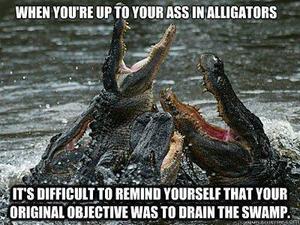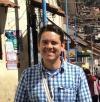When you are up to your ass in alligators—don’t build their capacities!
Blog post by Alfredo Ortiz
This post reflects the insights from Diederik’s earlier post. I share many of your concerns and feel that an even bigger problem is that many practitioners don’t figure these things out until after many years in the field. While I believe that some things can’t really be taught in advance of experience, I also think there are processes that can be used to be more reflective, more adaptive and generally spend more time talking about how real life is reacting to the things we do. Yet I think that many of us are too busy trying to change things (with mostly good intentions), and lacking “slow down” reflective tools—I think we learn too slowly and even do harm in the process.
A few years ago I was heading a regional field office for a US NGO in Ecuador and we were approached by a local-ish NGO (“ish” because they were a favorite son/daughter of the Inter American Foundation and a main trainer of Peace Corps volunteers) to help “strengthen their capacities”. This NGO had lost programs recently and was trying to regenerate itself in a real moment of existential questioning and change. We wrote a grant with them to fund our “capacity building” process, which included a highly formative (intentional training to go along with “process” oriented work) and received the grant. The process had bi-weekly sessions covering different areas of need, brought the group’s experience into it, and helped frame the issues better and make the group more knowledgeable and aware of what needed to be done. But at a certain point the director expressed frustration that, while this was all well and good (and indeed what had been designed, with them), she didn’t see how the process was helping them actually do anything to improve their somewhat desperate immediate situation. But we felt somewhat locked into our design because:
- we had a (trusted) consultant doing the work for us, with X number of days paid under this contract (we had no additional money to pay him;
- had already completed 2/3 of the process and felt it was better to finish than to simply stop (we didn’t want to not help and we felt this was our only vehicle through which to help); and,
- to do what was needed would have required a long and active accompaniment process that we were not well suited to offer.
In retrospect there are many remarkable elements to that experience. I’ll share one, which is that we were able, in collaboration with the organizational (client) representatives, to fundamentally misread the nature of the client’s challenging reality at the design phase. I think this is because we were steeped in a (particular—I don’t mean to generalize) culture of capacity building, which generally followed a process of:
- Carry out initial meetings with the organizational leader(s)
- Sketch out areas of need (really trying to understand needs here, but in short, efficient and few meetings). Not to worry, because the next step will resolve that
- “Design” a process that includes an organizational assessment, where broader organizational needs are surfaced (and they are)
- Develop an action plan to address needs
- In this particular process (not usually), offer training in areas of need, in addition to the action plan
- Visit the organization occasionally, but typically for meetings and not really accompanying or immersing ourselves in their reality
We reproduced a dominant way of acting, when these resources might have been used for a more emergent, action oriented process that didn’t get stuck in diagnostic phase, and actually helped them with the heavy lifting they needed.
This reminds me of a poster my brother and I gave our dad for his birthday one year (we were like 12 and 13): “When you’re up to your ass in alligators, it is difficult to remind yourself that your original objective was to drain the swamp!” This organization was clearly up to their asses in alligators, and we helped them describe how many, how sharp their teeth were, why they didn’t drain the swamp, what actions should be taken to make sure this does not happen again, etc. Where was my 12 year old self when I needed him! 
I AM AN ASSISTANT PROFESSOR OF NONPROFIT MANAGEMENT AND SOCIAL CHANGE AT THE MIDDLEBURY INSTITUTE OF INTERNATIONAL STUDIES, AN ACTION-RESEARCHER, AND DESIGNER / FACILITATOR OF ORGANIZATIONAL CHANGE PROCESSES. IN ALL OF MY WORK I TRY TO PRIORITIZE CRITICAL REFLECTION ON HOW POWER RELATIONSHIPS BETWEEN (AND WITHIN) PEOPLE ENABLE AND CONSTRAIN “DESIRABLE” AND “FEASIBLE” CHANGE. I BELIEVE THAT INCREASED AWARENESS ON THE ROLE ALL PEOPLE PLAY IN INCLUDING AND EXCLUDING DIVERSE WAYS OF UNDERSTANDING AND ACTING IN THE WORLD CAN LEAD TO NEW PERSPECTIVES AND INCREASED INCLUSION OF MARGINALIZED PEOPLE, CAUSES, IDEAS AND WAYS OF KNOWING.
- Making Public Deliberations Inclusive with Mixed Methods AR - October 26, 2020
- Participatory action research with Aboriginal Elders: Ngulluk Koolunga Ngulluk Koort project - October 12, 2020
- Bringing the relational self to ART: Interview with Dr. Yvonne Skipper - October 1, 2020

